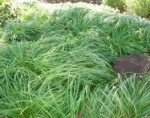Scientific Name: Carex wahuensis
Endemic: Kaua’i, O’ahu, Maui, Moloka’i, Lana’i, Hawaii
Description: Graceful sedges that form thick clumps and reach heights close to two feet tall, however, the long leaf blades droop downward and can actually reach lengths up to four feet long. These blades are about a half inch across at the base and gradually reduce to a narrow elongated apex. Tiny flowers emerge on the upper portion of long stalks called spikes. Once pollinated, the flowers become small seeds called achenes and can range in color from light brown to bright orange. Really attractive when contrasted against the dark green coloration of the surrounding foliage.
Distribution: The natural range of this endemic species is very diverse. Ivʻe seen them growing in the lowland dry-forest areas and upward into mesic and rain forests, from near the coast to elevations exceeding 3000 ft. Easy to find, Carex wahuensis can be seen growing on ridge lines in full sun or on slopes in the shadier under story in both relatively pristine and well disturbed surroundings. They exist on all the main islands except Kaho’olawe and Ni’ihau although they may have been found there in the past.
Cultural and Other Uses: The long slender leaf blades and seed clusters can be used to accentuate leis and can be used in flower arrangements.
Landscape Use and Care: I love the way Carex wahuensis looks in landscapes. They can be used either as accents around larger landscaping stones and at base of taller plants or as border plantings to define walkways and edges, similar to a low hedge. Their fine, fibrous roots are great for controlling erosion and can be planted as a mass groundcover even on steep slopes. These plants are highly versatile and can handle moderate to little watering as well as full sun to partial shade, they also standup well in areas of high winds. In fact they look really cool if placed in high “wind tunnel” like areas, their long leaf blades enable them to dance and flutter with the wind. You can even use Carex wahuensis as an indoor plant or as part of a “Living Wall” system.
Extra Info: Although there is no known Hawaiian name for this plant that is not to say that it never had one, most likely it was lost over the years. As common and beautiful as this plant is it would be hard to believe that Hawaiians didn’t recognize and name it themselves.
Carex








